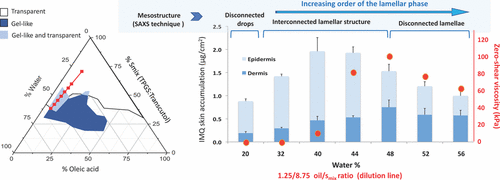当前位置:
X-MOL 学术
›
Mol. Pharmaceutics
›
论文详情
Our official English website, www.x-mol.net, welcomes your feedback! (Note: you will need to create a separate account there.)
Gel-like TPGS-Based Microemulsions for Imiquimod Dermal Delivery: Role of Mesostructure on the Uptake and Distribution into the Skin
Molecular Pharmaceutics ( IF 4.9 ) Pub Date : 2017-09-01 00:00:00 , DOI: 10.1021/acs.molpharmaceut.7b00348 Isabella Telò 1 , Elena Del Favero 2 , Laura Cantù 2 , Noemi Frattini 1 , Silvia Pescina 1 , Cristina Padula 1 , Patrizia Santi 1 , Fabio Sonvico 1 , Sara Nicoli 1
Molecular Pharmaceutics ( IF 4.9 ) Pub Date : 2017-09-01 00:00:00 , DOI: 10.1021/acs.molpharmaceut.7b00348 Isabella Telò 1 , Elena Del Favero 2 , Laura Cantù 2 , Noemi Frattini 1 , Silvia Pescina 1 , Cristina Padula 1 , Patrizia Santi 1 , Fabio Sonvico 1 , Sara Nicoli 1
Affiliation

|
The aim of this work was to develop an innovative microemulsion with gel-like properties for the cutaneous delivery of imiquimod, an immunostimulant drug employed for the treatment of cutaneous infections and neoplastic conditions. A pseudoternary phase diagram was built using a 1/1 TPGS (d-α-tocopheryl polyethylene glycol 1000 succinate)/Transcutol mixture as surfactant system, and oleic acid as oil phase. Eight microemulsions—selected from the 1.25/8.75 oil/surfactants ratio, along the water dilution line (from 20 to 56% w/w)—were characterized in terms of rheological behavior, optical properties via polarized microscopy, and supramolecular structure using X-ray scattering. Then, these formulations were loaded with imiquimod and the uptake and distribution into the skin was evaluated on full-thickness porcine skin. X-ray scattering experiments revealed the presence of disconnected drops in the case of microemulsion with 20% water content. Diluting the system up to 48% water content, the structure turned into an interconnected lamellar microemulsion, reaching a proper disconnected lamellar structure for the highest water percentages (52–56%). Upon water addition, also the rheological properties changed from nearly Newtonian fluids to gel-like structures, displaying the maximum of viscosity for the 48% water content. Skin uptake experiments demonstrated that formulation viscosity, drug loading, and surfactant concentration did not play an important role on imiquimod uptake into the skin, while the skin penetration was related instead to the microemulsion mesostructure. In fact, drug uptake became enhanced by locally lamellar interconnected structures, while it was reduced in the presence of disconnected structures, either drops or proper lamellae. Finally, the data demonstrated that mesostructure also affects the drug distribution between the epidermis and dermis. In particular, a significantly higher dermal accumulation was found when disconnected lamellar structures are present, suggesting the possibility of tuning both drug delivery and localization into the skin by modifying microemulsions composition.
中文翻译:

咪喹莫特皮肤递送的基于凝胶的基于TPGS的微乳剂:介观结构对皮肤吸收和分布的作用
这项工作的目的是开发一种具有凝胶样特性的创新微乳液,用于皮肤传递咪喹莫特(一种用于治疗皮肤感染和赘生性疾病的免疫刺激药物)。使用1/1 TPGS(d-α-生育酚聚乙二醇1000琥珀酸酯)/ Transcutol混合物作为表面活性剂体系,油酸作为油相。沿着水稀释线(从20%到56%w / w,从1.25 / 8.75油/表面活性剂的比率中选择)选择了八种微乳状液,以流变行为,通过偏振显微镜的光学性质以及使用X-的超分子结构进行了表征射线散射。然后,在这些制剂中加入咪喹莫特,并在全厚度猪皮肤上评估其在皮肤中的吸收和分布。X射线散射实验表明,在含水量为20%的微乳液情况下,存在不连续的液滴。将系统稀释至最高48%的水含量后,该结构变成了相互连接的层状微乳液,达到适当的不连续层状结构,以达到最高的水百分比(52–56%)。加水后,流变性质也从几乎牛顿流体变为凝胶状结构,在48%的水含量下显示出最大的粘度。皮肤吸收实验表明,制剂粘度,载药量和表面活性剂浓度对咪喹莫特对皮肤的吸收没有重要作用,而皮肤渗透却与微乳液的介观结构有关。实际上,局部层状相互连接的结构增强了药物的吸收,而在液滴或适当的层状结构相互分离的情况下,药物的吸收减少了。最后,数据表明介观结构还影响表皮和真皮之间的药物分布。尤其是,
更新日期:2017-09-04
中文翻译:

咪喹莫特皮肤递送的基于凝胶的基于TPGS的微乳剂:介观结构对皮肤吸收和分布的作用
这项工作的目的是开发一种具有凝胶样特性的创新微乳液,用于皮肤传递咪喹莫特(一种用于治疗皮肤感染和赘生性疾病的免疫刺激药物)。使用1/1 TPGS(d-α-生育酚聚乙二醇1000琥珀酸酯)/ Transcutol混合物作为表面活性剂体系,油酸作为油相。沿着水稀释线(从20%到56%w / w,从1.25 / 8.75油/表面活性剂的比率中选择)选择了八种微乳状液,以流变行为,通过偏振显微镜的光学性质以及使用X-的超分子结构进行了表征射线散射。然后,在这些制剂中加入咪喹莫特,并在全厚度猪皮肤上评估其在皮肤中的吸收和分布。X射线散射实验表明,在含水量为20%的微乳液情况下,存在不连续的液滴。将系统稀释至最高48%的水含量后,该结构变成了相互连接的层状微乳液,达到适当的不连续层状结构,以达到最高的水百分比(52–56%)。加水后,流变性质也从几乎牛顿流体变为凝胶状结构,在48%的水含量下显示出最大的粘度。皮肤吸收实验表明,制剂粘度,载药量和表面活性剂浓度对咪喹莫特对皮肤的吸收没有重要作用,而皮肤渗透却与微乳液的介观结构有关。实际上,局部层状相互连接的结构增强了药物的吸收,而在液滴或适当的层状结构相互分离的情况下,药物的吸收减少了。最后,数据表明介观结构还影响表皮和真皮之间的药物分布。尤其是,



























 京公网安备 11010802027423号
京公网安备 11010802027423号